Italian Garden Ideas: Transform Your Outdoor Space with Mediterranean Charm
Creating an Italian garden can transform your outdoor space into a serene Mediterranean escape. Whether you’re inspired by the elegance of a Tuscan villa or the lush greenery of the Amalfi coast, an Italian garden brings timeless beauty and tranquility to your home.
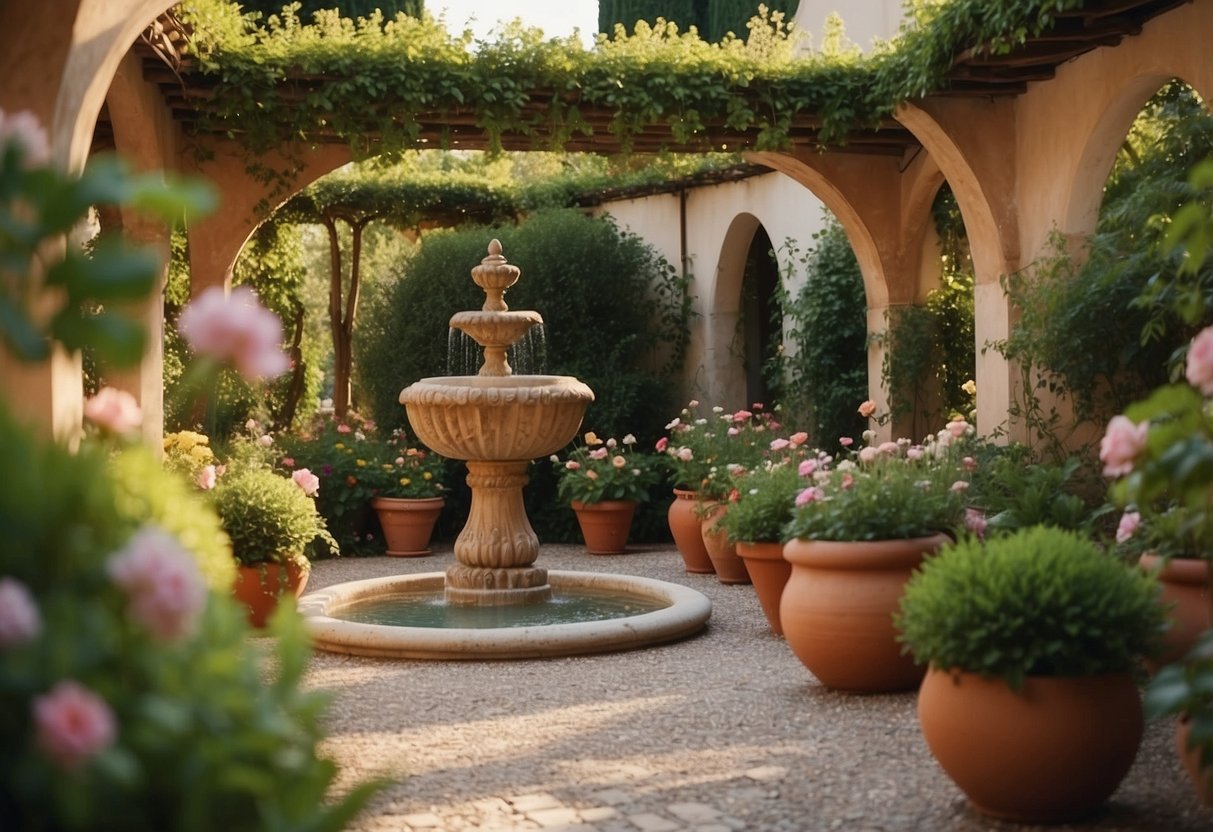
You’ll find that these gardens rely on simplicity, order, and a connection with nature. From classic cypress trees to charming stone paths, the elements of an Italian garden offer a blend of artistry and function that can make your landscape feel like an Italian retreat.
1) Terracotta Planters

Terracotta planters add a warm, rustic touch to your garden. They are perfect for creating that charming Italian vibe.
You can fill them with herbs like basil, oregano, and thyme. These planters are not only functional but also bring a bit of Italy to your space.
Mix and match different sizes and shapes for an inviting look. The earthy tones of terracotta go well with almost any plant you choose.
2) Boxwood Hedges

Boxwood hedges are an elegant addition to any Italian garden. These evergreens are known for their lush, green foliage and their versatility in landscaping.
You can use boxwood hedges to frame garden paths or create defined borders around your garden beds. They require minimal maintenance and can be easily shaped with an occasional light trim.
For a formal look, plant boxwood hedges in symmetrical patterns or geometric designs. This will enhance the ordered and manicured style typical of Italian gardens. Consider using a series of boxwood mounds to highlight entryways or hardscaping for added sophistication.
3) Wrought Iron Gates

Adding wrought iron gates to your Italian garden can bring a touch of elegance and classic beauty. These gates often feature intricate designs and detailing that can take your garden’s entrance to the next level.
A beautiful ornamental wrought iron gate can leave visitors amazed. The gates can serve as both a functional entryway and a stunning decoration.
Besides, using a wrought-iron gate can help define garden spaces while complementing stone or brick paths. They add character and charm to your garden.
4) Pergola with Vine Plants

Creating a pergola with vine plants adds a touch of Italian charm to your garden. Plants such as wisteria, grapevines, and trumpet vines are perfect choices. They not only provide shade but also drape beautifully over the pergola.
Consider your region’s climate when selecting vines. Choose varieties that will thrive in your environment to ensure healthy growth. Regular pruning is essential to keep your pergola looking neat and inviting.
Adding a mix of colorful blooms can make the space even more enchanting. Imagine relaxing under a canopy of lush green, dotted with flowers, right in your own backyard.
5) Classic Marble Fountain

A classic marble fountain adds elegance to any garden. Its timeless design brings a touch of luxury and sophistication.
You can opt for a tiered style, which looks grand and majestic, or a wall fountain that blends seamlessly with your surroundings.
Whether you prefer a traditional or modern look, a marble fountain can be a stunning focal point in your garden.
Explore options like the 19th Century Italian Marble Wall Fountain for an authentic touch. Discover more ideas at Authentic Provence.
6) Lavender Borders
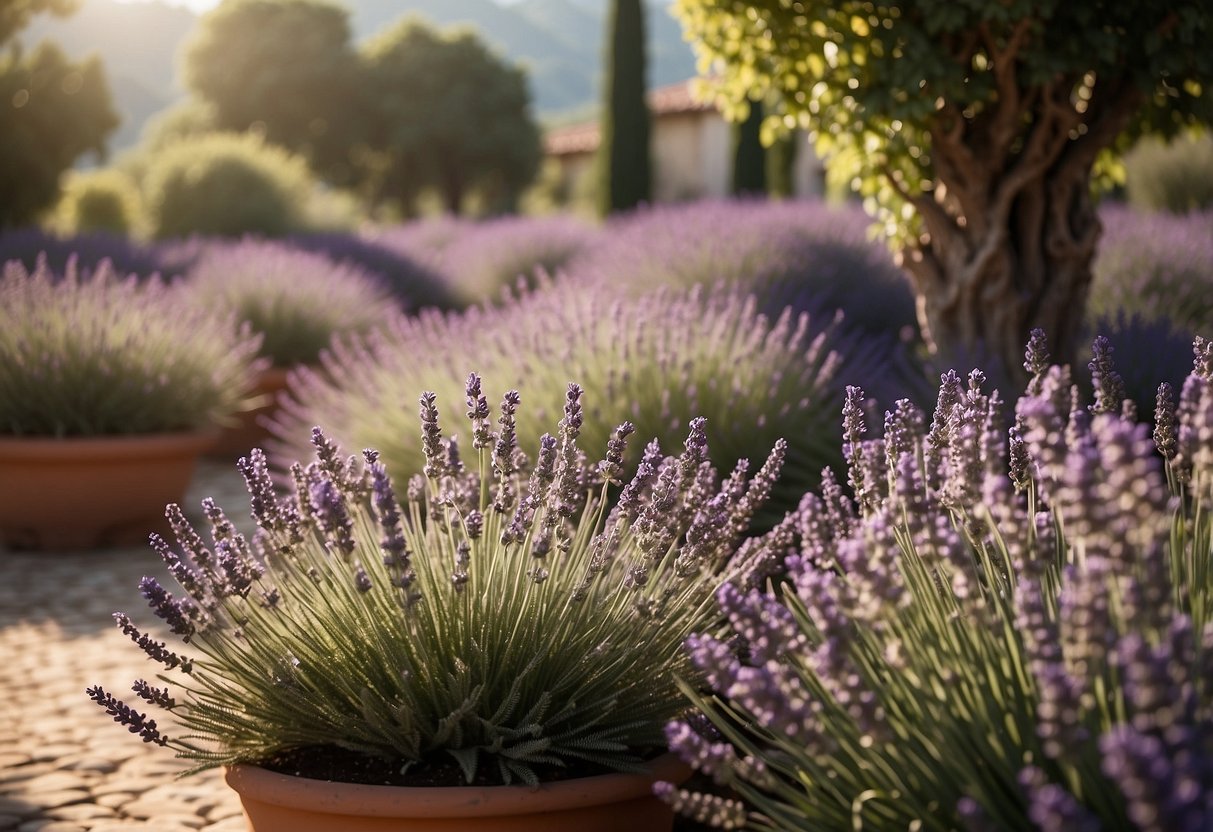
Using lavender as a border in your Italian garden adds both color and fragrance. Lavender plants create a charming boundary along pathways or garden beds. They are easy to grow and maintain, thriving in sunny spots with well-drained soil.
Lavender borders also attract bees and butterflies, enhancing the natural beauty of your garden. For more ideas on landscaping with lavender, check out these tips.
7) Olive Trees

Olive trees are a staple in any Italian garden. They add a touch of classic Mediterranean charm and are known for their longevity and resilience. With proper care, olive trees can thrive for centuries.
These trees prefer well-drained soil and plenty of sunlight. Their silvery-green leaves create a beautiful contrast against other plants in your garden.
Olive trees not only bring beauty but also the potential for homegrown olives. Imagine harvesting your own olives for oil or table use. They are both decorative and functional, making them a fantastic addition to your garden.
8) Lemon Trees in Pots
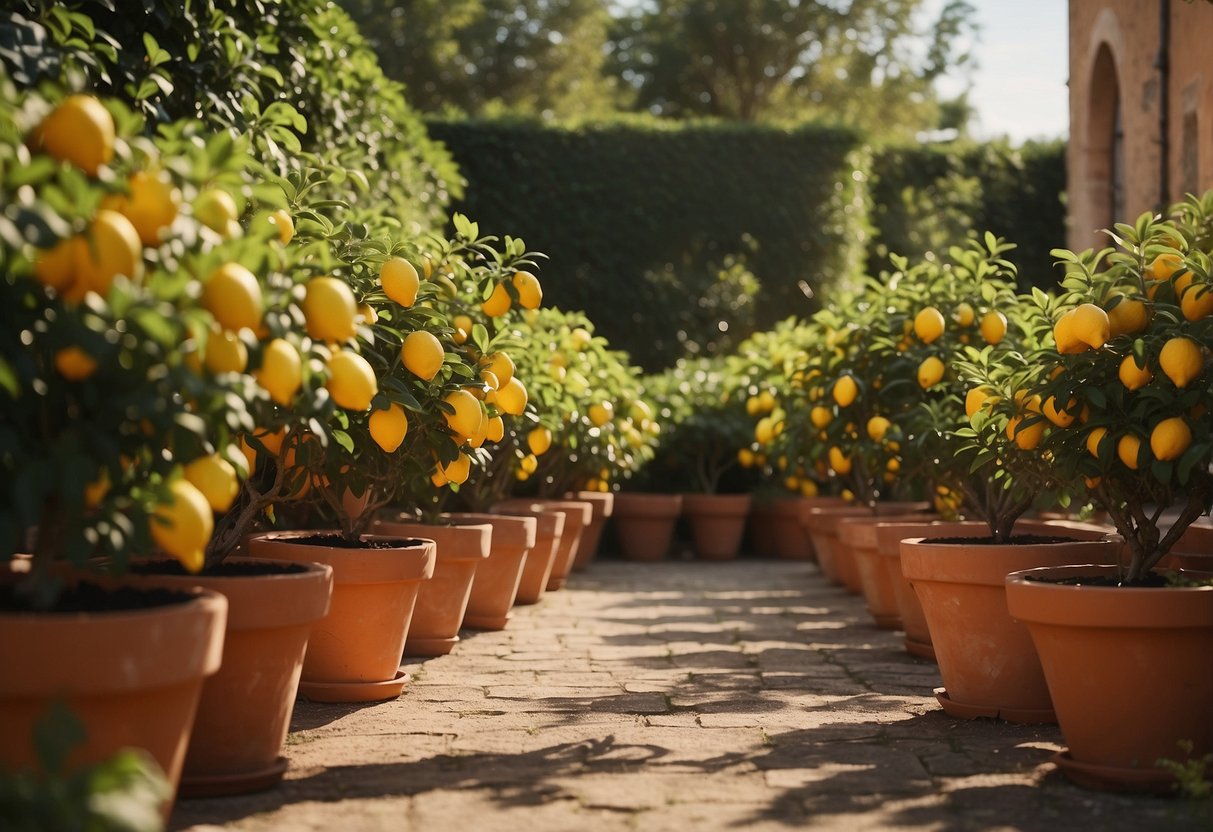
Lemon trees in pots can bring a touch of Italy to your garden. They are perfect for adding color and fragrance without needing a large space.
Choose a sturdy pot with good drainage. Use a soil mix that includes horticultural grit, loam, and leaf mold to prevent root rot.
Water the tree deeply but allow it to dry slightly between waterings. Keep your lemon tree in a sunny spot to help it thrive.
For further inspiration, check out this guide on designs and illustrations for lemon trees in pots.
9) Rustic Stone Pathways

Rustic stone pathways add charm and elegance to your Italian garden. They can be made from various materials like flagstone, slate, or cobblestones. The natural look of these stones blends well with lush greenery.
By using gravel paths and rustic stones, you create inviting walkways that meander through the garden. These paths encourage exploration and add a tactile connection to your space.
Including stone paths alongside elements like terra cotta pots and wrought iron furniture enhances the rustic feel of your garden. These features make your outdoor space feel authentic and timeless.
10) Herb Raised Beds
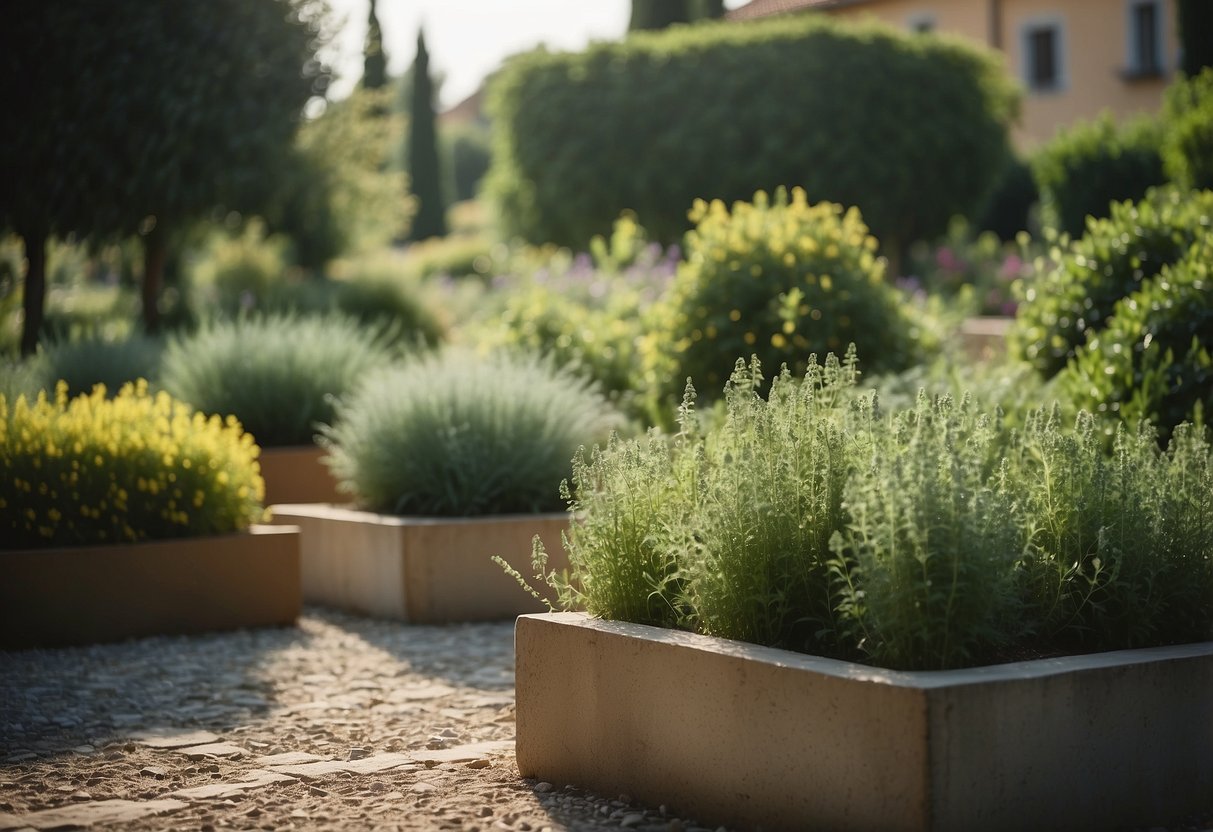
You can grow a variety of herbs in raised beds to bring fresh flavors to your kitchen. Using raised beds helps you control the soil quality and drainage.
Choose herbs like thyme, rosemary, and basil. For healthy growth, prune regularly for robust plants. Most herbs need at least a foot of soil. Some, like rosemary, need up to two feet.
Raised beds are especially good for herbs with larger roots. They can make your garden look neat and organized. An herb spiral is another option. It’s a raised garden built in a spiral shape, offering different growing conditions within the same bed.
Design Principles of Italian Gardens
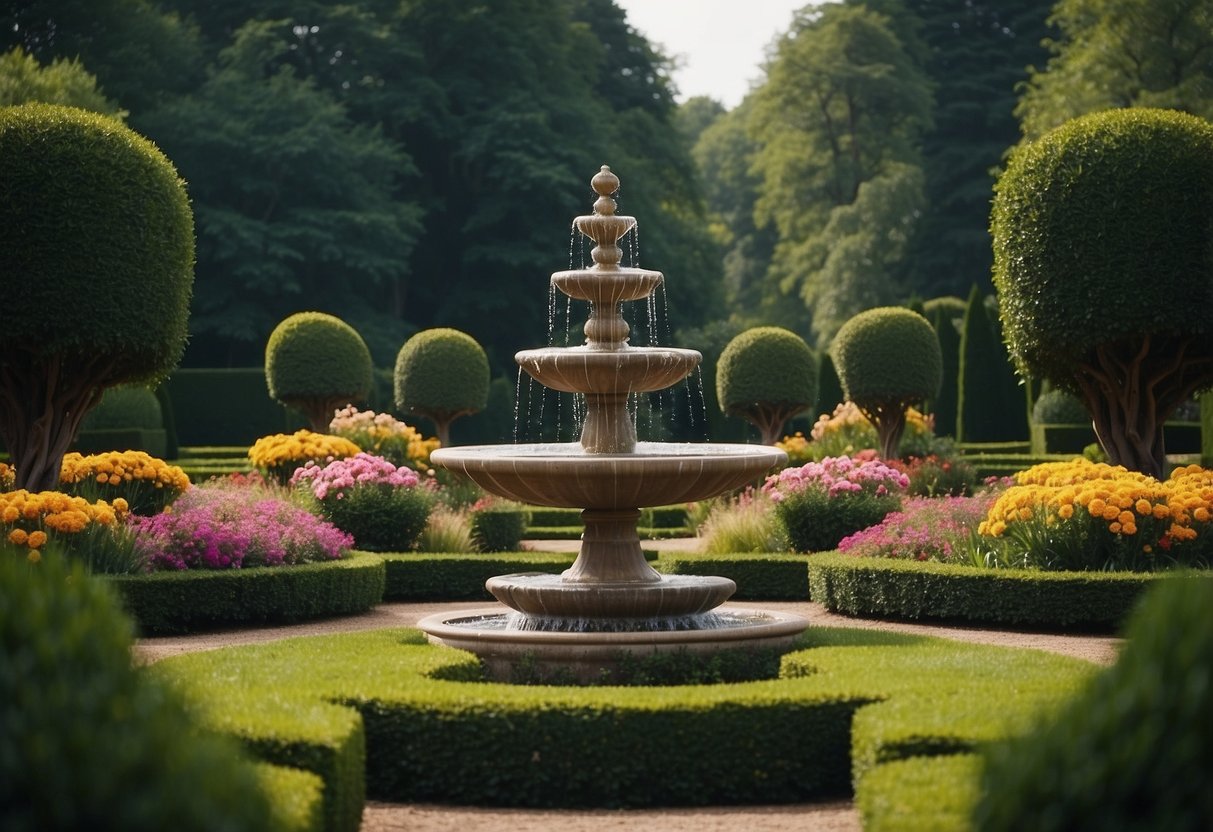
Italian gardens are defined by their simplicity, symmetry, and integration of water features. These elements create a harmonious and calming environment that is both aesthetically pleasing and functional.
Simplicity and Symmetry
Italian gardens thrive on simplicity and symmetry. The goal is to create a balanced look that is both elegant and structured.
Paths are laid out in straight lines or gentle curves. Manicured evergreens like boxwoods form neat hedges and borders, adding to the orderly feel.
Flowers are usually limited to one or two colors. This approach avoids a cluttered look and promotes harmony. For example, bright red geraniums can stand out beautifully against green foliage.
Hardscape elements such as columns and arches add architectural interest without overwhelming the natural elements. Stone benches and statues are arranged symmetrically to enhance the garden’s refined atmosphere. This focus on simplicity and symmetry ensures a cohesive and inviting space.
Use of Water Features
Water features are key in Italian gardens, offering tranquility and a cooling effect. They serve both practical and decorative purposes.
Fountains are common, ranging from simple wall fountains to elaborate multi-tiered ones. These add a soothing sound and a focal point in the garden.
Small ponds or reflecting pools can also be integrated. Surrounded by stone or gravel, these elements add depth and a sense of serenity. They often reflect the sky and surrounding plants, enhancing the garden’s visual appeal.
Streams and rills might meander through the garden. These flowing water features help connect different parts of the garden while adding a dynamic element. Incorporating water features brings a refreshing vibe to the space, making it both restful and lively.
Choosing the Right Plants

Creating an Italian garden involves selecting plants that thrive in Mediterranean climates and add classic beauty. Two key categories are Mediterranean flora and herbs with aromatic properties.
Mediterranean Flora
These plants are known for their resilience and ability to flourish in warm, dry conditions. Key plants include:
- Olive Trees: Olive trees are emblematic of Italian landscapes. Their silvery-green leaves add a classic look, and they require little water once established.
- Italian Cypress: Tall and slender, these trees are perfect for creating vertical interest. They also add a sense of timelessness to your garden.
- Lavender: Known for its fragrant flowers and low maintenance, lavender provides both beauty and a lovely scent. It’s excellent for borders and pathways.
- Agave and Aloe Vera: These succulents thrive in poor, chalky soil. They require minimal water and add a unique texture to the garden.
- Geraniums: Consider bright red geraniums to contrast with the greenery. They can add a vibrant touch and thrive well in the Mediterranean sun.
Choosing the right Mediterranean plants ensures your garden remains both picturesque and manageable.
Herbs and Aromatic Plants
Italian gardens often feature a variety of herbs and aromatic plants, enhancing both the garden’s beauty and your kitchen.
- Basil: A staple in Italian cooking, basil is easy to grow and can thrive in pots or garden beds with plenty of sunlight.
- Rosemary: This hardy herb provides aromatic foliage and beautiful blue flowers. It’s great for cooking and requires very little care.
- Thyme: Perfect for ground cover, thyme is robust and adds a fresh scent to your garden. It’s also a versatile culinary herb.
- Sage: Sage offers both lovely green leaves and culinary uses. It needs well-drained soil and plenty of sunlight to thrive.
- Parsley: Parsley is a biennial and should be started anew each year in areas with cold winters. It’s an essential herb for many Italian dishes and grows well in various conditions.
Herbs not only provide culinary benefits but also contribute to the garden’s aromatic charm.
Incorporating Garden Structures

Adding structures to your Italian garden can create focal points and enhance its beauty. Two key features are pergolas and trellises, as well as garden statues and sculptures.
Pergolas and Trellises
Pergolas offer shade and define outdoor spaces. They can be used to create cozy seating areas or provide a shaded path through your garden. For a true Italian feel, consider using materials like wood or wrought iron, and adorn the structure with climbing plants such as grapevines, wisteria, or roses. These plants not only add beauty but also bring delightful scents to your garden.
Trellises are perfect for supporting climbing plants and adding vertical interest. Place them against walls or use them as dividers within your garden. They work well with plants like clematis or jasmine, which thrive in sunlit areas. Using trellises can help you make the most of smaller spaces by growing plants upwards rather than outwards.
Garden Statues and Sculptures
Statues can bring classical charm to your garden. Consider adding figures of Roman or Greek gods, goddesses, or mythical creatures. These pieces can serve as focal points in open spaces or nestled within greenery, giving your garden a touch of antiquity and artistic flair.
Sculptures don’t have to be traditional. Modern art pieces can also blend well, especially if you prefer a contemporary twist. Look for sleek, minimalist designs that contrast with the natural surroundings. Position these sculptures where they can catch the eye, such as at the end of a gravel path or beside a water feature.
By thoughtfully incorporating these structures, you can enhance the overall aesthetic and functionality of your Italian garden.







